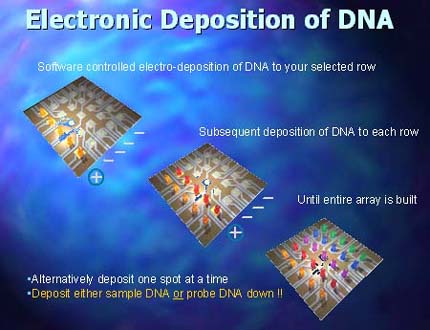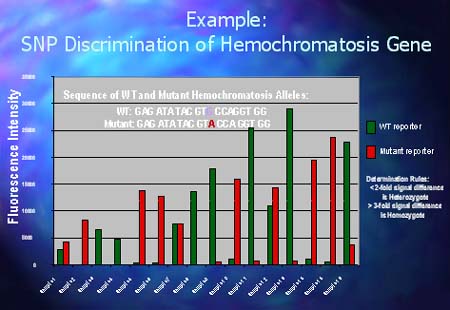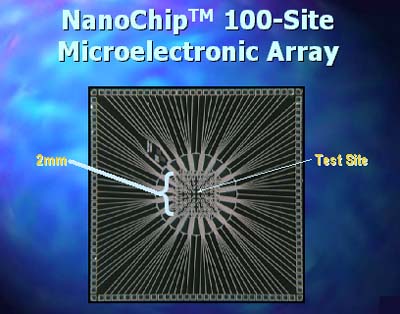Nanogen does it with electricity
Table of Contents
Electronic addressing
An array of options
Cases in point
What's available
The future of NanoChip
Here's a biochip unlike any other—one based on the electrical properties of biological molecules. Using microelectronics, Nanogen, Inc.'s (San Diego) technology moves and concentrates charged molecules to and from designated test sites on a semiconductor microchip. This technology offers flexibility not available with other arraying technologies. It allows test sites to be arranged at the end-user's discretion in various configurations on the microchip. In addition, the chip offers flexibility in experimental design—you choose what's arrayed, whether it's DNA probes or samples, depending on your goals. And the electronic addressing technology described below allows for multiple experiments to be conducted simultaneously on the same chip. Lastly, it's fast—using electricity generates results in just a few minutes compared to hours for passive hybridization.
Electronic addressing
The NanoChip Molecular Biology Workstation uses a process called electronic addressing to place DNA fragments at specific sites on a silicon microchip. Being negatively charged, DNA will move to areas of positive charge on the chip just as metal is attracted to a magnet. First, a DNA solution is introduced onto the microchip. Next, a test site or multiple test sites on the microchip are electronically activated with a positive charge. The negatively charged probes move rapidly to the positively charged sites, where they are concentrated and bound by a chemical process to that site. The microchip is then washed, another DNA solution of distinct DNA probes is added, and different test sites are activated. Site by site, row by row, an array of specifically bound DNA probes can be assembled or addressed on the microchip in a user-defined order. This entire process is automated, allowing the operator the freedom to perform other activities while the microchip is being addressed.

Compared to spotting and photolithographic technologies for creating arrays, these microchip arrays are relatively quick to make, and at a minimal cost. Costs are based on the customers' preparation of probes and amplicons as well as the $175 price of the NanoChip microelectronic array.
Once arrayed, the NanoChip is now prepared to perform a genetic analysis, once again using the power of electronics. A sample can be applied to test for the presence of particular DNA mutations or polymorphisms by determining which of the DNA capture probes on the array hybridizes with complementary DNA in the test sample. The sample DNA is moved and concentrated by electricity, in contrast to conventional arrays where reactions occur passively on paper or glass "chips." In addition, a special buffer solution in conjunction with electric control of the array allows the user to isolate a reaction over one test site, a few test sites, or the whole array. In contrast, conventional arrays are all or nothing where reactions occur on all array sites once the sample is added.
An array of options
One feature that sets the NanoChip apart from other microchips is the flexibility in experimental design that it affords. You can spot sample or probe on any given test site on the microchip. This allows you to screen one sample for many different types of results or many samples for one result depending on your needs. Since you can hybridize only the sites you want by specifying particular sites for electronic concentration and hybridization, you can run multiple experiments on the same chip. Furthermore, since each test site is under separate electronic control, the experimental conditions for each assay site on the chip can be fully optimized for that assay. You can run hybridizations at different times or strengths, again all tailored to the particular assay on that test site. Quite an array of options.
Cases in point
The NanoChip has already scored successes with several of Nanogen's partners. Late last year, collaborators from the Mayo Clinic reported on experiments using the NanoChip to examine SNPs for the thiopurine methyl transferase gene, in which they achieved 100% accuracy in scoring (see related article).
While earlier this year, Glen Evans, professor of internal medicine at University of Texas Southwestern, used the NanoChip system to genotype more than 200 individuals for 12 clinically relevant SNPs, again with 100% accuracy. This study nicely demonstrates the NanoChip's multiplexing capability and flexibility. Amplified genomic DNA from one patient was accurately scored for as many as 12 functional SNPs of pharmacogenomic significance on a single microelectronic chip. In a second design, 32 patient samples arrayed on a single microchip were scored for one SNP per sample, demonstrating the utility of the NanoChip for genotyping studies.

What's available
And now, you can have this technology in your laboratory, as Nanogen has made the NanoChip commercially available. The original microchip contained a five-by-five array of 25 independent test sites per microchip. But now Nanogen is offering a 100 electrode microchip, and under development are microchips containing electrodes based on CMOS process integrated circuit designs, which may offer the capability of arrays of 10,000 or more sites.

Nanogen also supplies a fully automated instrument that controls all aspects of microchip operation, consisting of:
- NanoChip Loader—a fluid handling subsystem that controls test sample application and washing steps;
- NanoChip Reader—a highly sensitive, laser-based fluorescence scanner that detects molecular binding; and
- computer software that controls all microchip operations and tabulates test results.
The future of NanoChip
While the present emphasis is on various genomic assays, the NanoChip has a multitude of uses. For example, a 1998 study by Nanogen scientists published in the journal Analytical Chemistry revealed how the chip can be used to separate cells based on their differential dielectric properties (ref. 1). More recently, a method for anchored amplification, using proprietary strand displacement amplification, was described (ref. 2). Here, up to ten primer sets anchored in distinct areas on the microchip created zones of amplification, with no loss of efficiency, a common problem with most other methods for multiplexing PCR reactions.
And that's not all. Nanogen is working on a portable version for field testing samples, with applications in clinical as well as forensic science. And then there's a variety of other macromolecular interactions that could be analyzed via the NanoChip—antigen-antibody complexes, enzyme-substrate interactions, cell-receptor, the list goes on.
References
- Cheng, J., Sheldon, E.L., Wu, L., Heller, M., and O'Connell, J., "Isolation of Cultured Cervical Carcinoma Cells Mixed with Peripheral Blood Cells on a Bioelectronic Chip," Analytical Chemistry, 70: 2321-2326, 1998.
- Westin, L, Xu, X , Miller, C , Wang, L, Edman, CF, and Nerenberg, M., "Anchored multiplex amplification on a microelectronic chip array," Nature Biotechnology 18: 199-204, 2000.
For more information: Gregory J. Gosch, Marketing Manager, Nanogen, 10398 Pacific Center Ct., San Deigo, CA 92121. Tel: 858-410-4600. Fax: 858-410-4949.
By Laura DeFrancesco
Managing Editor, Bioresearch Online
